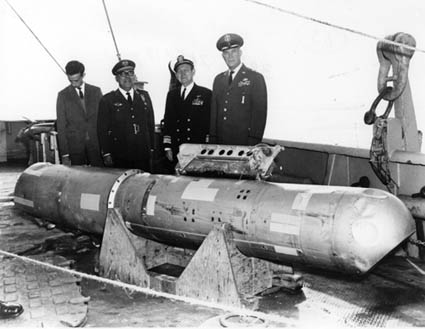On January 15, 1966, a seemingly routine mid-air refueling mission off the coast of Spain turned into one of the Cold War’s most bizarre nuclear accidents. A U.S. Air Force B-52 bomber, carrying four hydrogen bombs, collided with a KC-135 refueling plane at 31,000 feet. What followed was a chaotic mix of explosions, parachuting bombs, and an international scramble to recover the world’s most dangerous weapons.

The Mid-Air Collision That Shook the World
As the B-52 approached the KC-135 for refueling over the small Spanish villages of Palomares and Villaricos, disaster struck. The two planes collided, causing a fiery explosion that killed all four crew members aboard the KC-135 and three of the seven on the B-52. The bomber broke apart, and its payload—four Mk-28 hydrogen bombs, each with an explosive yield 1,250 times greater than the Hiroshima bomb—fell from the sky.
Fortunately, these nuclear weapons were not armed, preventing an apocalyptic detonation. But that didn’t mean the ordeal was over. The bombs, designed with parachutes for controlled descent, scattered across land and sea, leading to a frantic recovery mission.
A Village, A Vineyard, and a Very Dangerous Surprise
One bomb landed harmlessly in a dry riverbed, another was found in a cemetery field, and a third crashed into a tomato farm, breaking apart on impact. Local farmer Eduardo Navarro and his neighbors rushed to the scene, unknowingly kicking and shoveling dirt onto what was, in fact, a nuclear bomb. Luckily, no nuclear reaction occurred, but the conventional explosives inside detonated, spreading radioactive plutonium dust across nearly two square kilometers of farmland.
The fourth bomb, however, was missing.
The Hunt for a Sunken Nuke
While U.S. military personnel scoured the land for radioactive contamination, a separate high-stakes mission unfolded at sea. A Spanish fisherman, Francisco Simó Orts, reported seeing a strange metallic object fall into the Mediterranean. His sighting proved crucial. The U.S. launched an unprecedented deep-sea search, deploying over 3,000 personnel, 18 ships, and cutting-edge technology to locate the lost nuke.
After 79 days of relentless searching and an estimated cost of $20 million, the bomb was finally discovered nearly 800 meters below the surface. It was retrieved on April 7, 1966, in what became one of the most remarkable deep-sea recoveries in military history.
Fallout: Politics, Pollution, and Pop Culture
The Palomares Incident had far-reaching consequences. The Spanish government was outraged, leading to diplomatic tensions with the U.S. Over 4,810 barrels of contaminated soil were shipped to South Carolina for disposal. The cleanup effort, though extensive, didn’t fully eliminate the radiation threat—studies have found lingering plutonium contamination in the area even decades later.
Curiously, just two weeks before the accident, the James Bond movie Thunderball had hit theaters, featuring a plot about stolen nuclear bombs lost at sea. Hollywood struck again in 2000 with Men of Honor, a film that dramatized aspects of the Palomares recovery operation.
Today, the casings of two recovered bombs are displayed at the National Museum of Nuclear Science & History in New Mexico, silent reminders of the day nuclear weapons quite literally fell from the sky.

No comments yet.